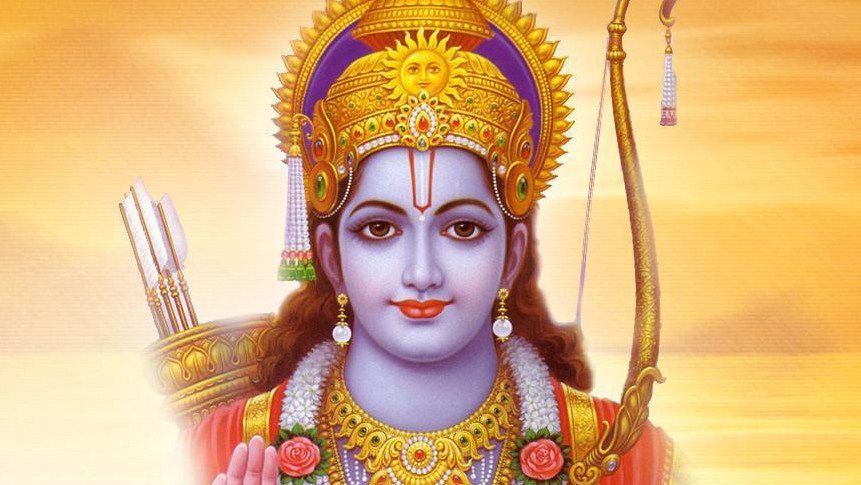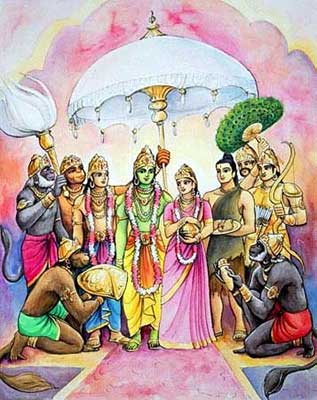Who is Rama?


Introduction
As I was in the car with my dad listening to the Vishnu Sahasranama chanting, the sloka “Sri Rama Rama Rameti Rame Raame Mano Rame Sahasranama Tattulyam Rama Nama Varanane.” From that day I began to wonder who is Rama? Then I started researching Lord Rama and here are my findings.
Background Information
Lord Rama was the son of King Dasaratha and Queen Kausalya. He was born in Ayodhya, one of the seven sacred cities in India. He is the seventh reincarnation of Vishnu (A Hindu God) and had three brothers Bharata, Lakshmana, and Shatrughna. Rama was said to live for about 10,052 years in which he went on many ventures including what was depicted in the Ramayana, through these ventures he learned about the importance of dharma and fulfilling one’s duty. Additionally, he also became the king of Ayodya.

Exile
Since Rama was next in line to be king, Rama’s stepmother Kaikayi made a deal with King Dasaratha (Rama’s father) saying that her son Bharata must become king. In order to do so, King Dasaratha is forced to send Rama on exile for the next 14 years as per the wishes of Kaikayi. Rama along with his wife Sita and his brother Lakshmana then proceed to go into exile. Following their departure, Bharata refuses to be king but because of Rama’s absence, he becomes the vice-regent up until Rama’s arrival back home. During exile, Rama saves Sita from a rakshasa named Ravana and then returns 14 years later to become king.

Meeting Hanuman
Rama meets Hanuman in the last year of exile after Sita is kidnapped by Ravana. They both meet on a mountain called Rishyamukh parvat. At the time Hanuman was a minister for Sugriva, who was the king of the Vanara kingdom.

Meeting Guha
Guha in Sanskrit means cave of the heart which signifies the Hindu philosophy behind his name. Guha, who is the king of Shrungabheripura helps Rama pass through the Ganges River. Before entering the boat Guha washes Rama’s feet, this is portrayed below in the quote and picture. Guha says to Rama “ Oh Rama! I heard the story of the stone turning into a woman(Ahalya) when your foot touched it. Now that you are getting into my boat, I don’t want my boat turning into a woman when you get into it. So let me clean your feet before getting into the boat“.

Meeting Vibhishana
Ravana expelled his younger brother Vibhishana from Sri Lanka because he tried to stop Ravana from fighting with Rama. Vibhishana then decides to help Rama instead. Though others were suspicious of Vibishana Hanuman assured them that he came in peace.
Vibhishana told Rama about Ravana’s strengths and weaknesses. He told Rama that Ravana had been granted the boon of immortality by Lord Brahma. He also told Rama about Ravana’s weapons, soldiers, army, and the method of warfare they were planning to use. He informed Rama about Indrajit’s ability to disappear and while fighting.
Performing Shiva Puja
In order to save Sita, Rama along with the Vanaras (army of monkeys) arrive at Sri Lanka where Sita and the citizens of Sri Lanka are being held captive by Ravana. However, because India and Sri Lanka are separated by the sea Rama wonders how he will be able to cross the sea. He then has a vision of Shiva while drinking water and proceeds to do a Shiva puja in which Shiva appears and responds to.
Fighting War with Ravana
In order to save Sita and the citizens of Sri Lanka Rama declares war with Ravana (the king of Sri Lanka). Rama’s army of bears and monkeys fight Ravana’s army of demons. Simultaneously, some of the Vanaras build a land bridge in order to rescue people including Sita.
Significance
Rama is an important historical figure in Hindu culture because of his strong moralistic values including helping others, sacrifice, and loyalty all of which are principles in Hinduism. Using his courage he is also able to defeat Ravana and Kumbakarna. Another moral value that he displays is always respecting others wishes, he displays this when his stepmother requests for him to go into exile. All of these values that Rama displays are very important in life, he is a well-worshipped god among Hindu people because of these reasons.

Rama coming back to Ayodhya
Following the defeat of Ravana at the end of the 14 years, Rama returns home along with Sita, Lakshmana, and Hanuman. Rama then proceeded to reclaim the throne of Ayodhya after Bharata had been ruling as regent since his exile.

About Ayodhya
Through the beliefs of many religions such as Hinduism, Jainism, and Buddhism Ayodhya is a significant location. This city is important to Hindus because Lord Rama was born here and therefore is a sacred place. In Jain culture, this city is where the founder of Jainism, Shri Rishabh Dev lived. He is also the first Tirthankar of the religion. A Tirthankar is someone who gone through many rebirths in life and has created a path for others to follow. Lastly, in Buddhism Ayodhya is important because the emperor of the Mauryan Empire (322–185 B.C.E.), Ashoka converts to Buddism after many wars and is able to spread peace and prosperity throughout this region thus, marking a large milestone in the spread of Buddism.
Ayodhya Geographical Information
Ayodhya is a city located in Northern India in the state of Uttar Pradesh. It turned into an urban settlement at around 5-6 BC. This city lies on the Ganghara river which is located east of Faizabad. The total land area of this city is about 30.81 mi² and also holds a population of 55,890 people.

Current Events
Recently, after the approval of the Indian Supreme Court, Prime Minister Narendra Modi announced the construction of a new Rama temple in Ayodya which was previously destroyed in the 15th century. The construction of the temple symbolizes Hindu nationalism and hope amid the novel coronavirus. On August 5th, 2020 (IST) a Bhoomi Puja had taken place prior to the building of the temple. The Bhoomi Puja is performed for Goddess Bhoomi who symbolizes Earth and the Pancha boothas which are water, air, sky, fire, and space. Performing this puja prior to construction is said to remove all the bad effects. Soil from about 2,000 pilgrimage sites and water from the various sacred rivers were obtained and brought to the puja. Following this Prime Minister Narendra Modi laid down a silver brick on the land for the foundation laying ceremony. It will likely take about three years for this temple to be built.

Citations
bbc.co.uk
wikipedia.com
ndtv.com
shortstoriesfromindiamythology.blogspot.com
quora.com
DISCLAIMER: The author is solely responsible for the views expressed in this article. The author carries the responsibility for citing and/or licensing of images utilized within the text.
